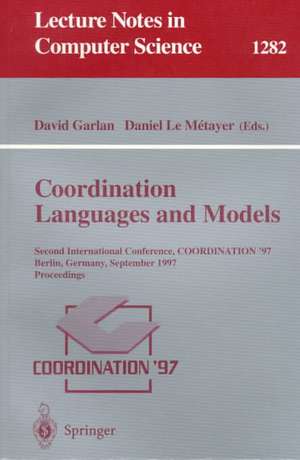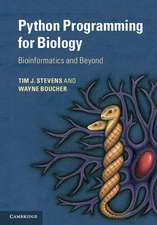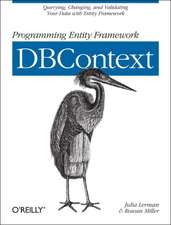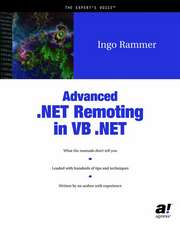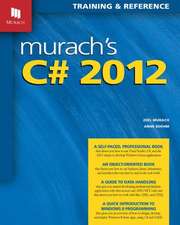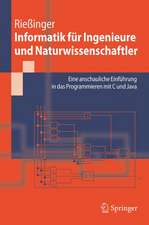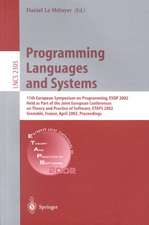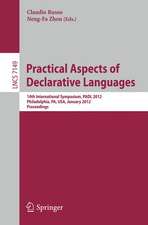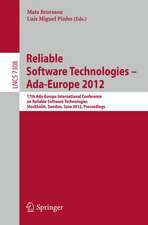Coordination Languages and Models: Second International Conference, COORDINATION'97, Berlin, Germany, September 1-3, 1997, Proceedings: Lecture Notes in Computer Science, cartea 1282
Editat de David Garlan, Daniel Le Metayeren Limba Engleză Paperback – 13 aug 1997
The 22 revised full papers and 6 posters presented in the book were carefully reviewed and selected from a total of 69 submissions. Also included are three invited papers. The papers are devoted to an emerging class of languages and models, which have been variously termed coordination languages, configuration languages, and architectural description languages. These formalisms provide a clean separation between software components and their interaction in the overall software organization, which is particularly important for large-scale applications and open systems.
Din seria Lecture Notes in Computer Science
- 20%
 Preț: 1061.55 lei
Preț: 1061.55 lei - 20%
 Preț: 307.71 lei
Preț: 307.71 lei - 20%
 Preț: 438.69 lei
Preț: 438.69 lei - 20%
 Preț: 645.28 lei
Preț: 645.28 lei -
 Preț: 410.88 lei
Preț: 410.88 lei - 15%
 Preț: 580.46 lei
Preț: 580.46 lei - 17%
 Preț: 427.22 lei
Preț: 427.22 lei - 20%
 Preț: 596.46 lei
Preț: 596.46 lei -
 Preț: 449.57 lei
Preț: 449.57 lei - 20%
 Preț: 353.50 lei
Preț: 353.50 lei - 20%
 Preț: 1414.79 lei
Preț: 1414.79 lei - 20%
 Preț: 309.90 lei
Preț: 309.90 lei - 20%
 Preț: 583.40 lei
Preț: 583.40 lei - 20%
 Preț: 1075.26 lei
Preț: 1075.26 lei - 20%
 Preț: 310.26 lei
Preț: 310.26 lei - 20%
 Preț: 655.02 lei
Preț: 655.02 lei - 20%
 Preț: 580.93 lei
Preț: 580.93 lei - 20%
 Preț: 340.32 lei
Preț: 340.32 lei - 18%
 Preț: 938.83 lei
Preț: 938.83 lei - 20%
 Preț: 591.51 lei
Preț: 591.51 lei - 15%
 Preț: 438.59 lei
Preț: 438.59 lei - 20%
 Preț: 337.00 lei
Preț: 337.00 lei -
 Preț: 389.48 lei
Preț: 389.48 lei - 20%
 Preț: 607.39 lei
Preț: 607.39 lei - 20%
 Preț: 1024.44 lei
Preț: 1024.44 lei - 20%
 Preț: 579.30 lei
Preț: 579.30 lei - 20%
 Preț: 763.23 lei
Preț: 763.23 lei - 20%
 Preț: 453.32 lei
Preț: 453.32 lei - 20%
 Preț: 575.48 lei
Preț: 575.48 lei - 20%
 Preț: 585.88 lei
Preț: 585.88 lei - 20%
 Preț: 825.93 lei
Preț: 825.93 lei - 20%
 Preț: 763.23 lei
Preț: 763.23 lei - 17%
 Preț: 360.19 lei
Preț: 360.19 lei - 20%
 Preț: 1183.14 lei
Preț: 1183.14 lei - 20%
 Preț: 340.32 lei
Preț: 340.32 lei - 20%
 Preț: 504.57 lei
Preț: 504.57 lei - 20%
 Preț: 369.12 lei
Preț: 369.12 lei - 20%
 Preț: 583.40 lei
Preț: 583.40 lei - 20%
 Preț: 343.62 lei
Preț: 343.62 lei - 20%
 Preț: 350.21 lei
Preț: 350.21 lei - 20%
 Preț: 764.89 lei
Preț: 764.89 lei - 20%
 Preț: 583.40 lei
Preț: 583.40 lei - 20%
 Preț: 649.49 lei
Preț: 649.49 lei - 20%
 Preț: 341.95 lei
Preț: 341.95 lei - 20%
 Preț: 238.01 lei
Preț: 238.01 lei - 20%
 Preț: 538.29 lei
Preț: 538.29 lei
Preț: 339.99 lei
Preț vechi: 424.99 lei
-20% Nou
Puncte Express: 510
Preț estimativ în valută:
65.06€ • 67.92$ • 53.84£
65.06€ • 67.92$ • 53.84£
Carte tipărită la comandă
Livrare economică 05-19 aprilie
Preluare comenzi: 021 569.72.76
Specificații
ISBN-13: 9783540633839
ISBN-10: 3540633839
Pagini: 452
Ilustrații: X, 435 p.
Dimensiuni: 155 x 235 x 24 mm
Greutate: 0.63 kg
Ediția:1997
Editura: Springer Berlin, Heidelberg
Colecția Springer
Seria Lecture Notes in Computer Science
Locul publicării:Berlin, Heidelberg, Germany
ISBN-10: 3540633839
Pagini: 452
Ilustrații: X, 435 p.
Dimensiuni: 155 x 235 x 24 mm
Greutate: 0.63 kg
Ediția:1997
Editura: Springer Berlin, Heidelberg
Colecția Springer
Seria Lecture Notes in Computer Science
Locul publicării:Berlin, Heidelberg, Germany
Public țintă
ResearchCuprins
From weaving threads to untangling the web: A view of coordination from Linda's perspective.- Exposing the skeleton in the coordination closet.- Design for open systems in Java.- Checking assumptions in component dynamics at the architectural level.- Security benefits from software architecture.- Regulated coordination in open distributed systems.- Debugging distributed applications using a coordination architecture.- Coordinating durative actions.- Communication-passing style for coordination languages.- Software architecture for large control systems: A case study description.- Evaluation of software architectures for a control system: A case study.- Modeling railway control systems using graph grammars: A case study.- On what Linda is: Formal description of Linda as a reactive system.- Three semantics of the output operation for generative communication.- Coordinating mobile agents via blackboards and access rights.- Modeling coordination via asynchronous communication.- Partial order and SOS semantics for linear constraint programs.- Programmable coordination media.- Safer tuple spaces.- Coordinating action systems.- Approximating unity.- Mobile UNITY coordination constructs applied to packet forwarding for mobile hosts.- From layer to layer — object-oriented protocol refinement in kannel.- An asynchronous model of locality, failure, and process mobility.- A component calculus for modeling the Olan configuration language.- A coordination model for distributed object systems.- Coordination patterns for parallel computing.- Concurrent Metatem as a coordination language.- Control-based coordination of human and other activities in cooperative information systems.- Using asynchronous tuple-space access primitives (Bonita primitives) for process co-ordination.-Berlinda: An object-oriented platform for implementing coordination languages in Java.
